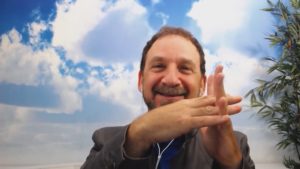Today SevenPonds concludes our two-part interview with Dr. Michael Fratkin, palliative medicine specialist and president and founder of ResolutionCare. (Read Part One here.) Birthed by Dr. Fratkin’s desire to expand palliative care beyond the limitations of our country’s broken healthcare system, ResolutionCare is a telemedicine project that uses videoconferencing technology and an interdisciplinary team to provide remote palliative care to patients in need.

Credit: youtube.com
Ellary: What is the origin story of ResolutionCare, as it developed beyond your initial experiments offering advice on complex illness via the Helpouts videoconferencing platform?
Dr. Fratkin: I discovered something called Project Echo from the University of New Mexico. Project Echo is a learning model that uses video conferencing as a way of spreading or democratizing, or
open-sourcing scarce expertise. My expertise is rare, and there are definitely not enough inspired teams to take care of everybody that’s out there. And there are a lot of primary care people and mid-level practitioners at community clinics all over the place who would benefit from knowing what I do — for example, the three things I focus on in terms of pain control, or how I talk to people about advanced care planning or pulse storms.
So I decided to try crowdfunding an end-of-life care team that used telemedicine and Project Echo to both take care of more people than they possibly could otherwise, and to teach other practitioners how to take care of themselves and their own patients. On Nov. 1, 2014, I launched a crowd funding campaign, and by December I’d raised $150,000. Then in January of last year I walked into this office space with Leanne, our administrative coordinator, and we started ResolutionCare.
Ellary: Who are some of the core members of your team?
Dr. Fratkin: Right now we’ve got myself, three nurses and a nurse manager. We’ve also got one social worker, and we’ve just hired another one. We’ve got a very funny and amazing chaplain and three community health workers, and I just recruited an additional fellowship-trained hospice medicine doctor. In addition to that, we have a three-quarter-time social worker in the hospice program at our community hospital. Then we’ve got seven or eight operational people and a couple of interns.

Credit: singularityweblog.com
Ellary: Now you use Zoom as your videoconferencing platform for meeting with patients. In fact, we’re using it right now. So, I am seeing you the way a patient would be see you, right?
Dr. Fratkin: Yes. You’ve interviewed by phone haven’t you?
Ellary: Yes.
Dr. Fratkin: This is different. We’re much more engaged. We’re literally framed to be attendant to each other. And you get to be in your own comfy little zone, and so do I. It’s a change in the power structure.
I often ask patients to show me where they keep their medicines and how they organize them. And they can show me that, and I can see that it’s, for example, this big bin of conflicting crazy medicines that they don’t have very well organized. So I can send a nurse out, or put a nurse in touch with them so they can help organize the medicines.
Ellary: You get a lot of information that you would never have access to without the patient being in their own spaces, where they are existing on a day-to-day basis with their illness.
Dr. Fratkin: For sure. If a doctor comes over to your house, for a lot of people that’s a big deal. People want to impress you. They get all dressed up; they vacuum; they get all wigged out. But this way I have the benefit of just dropping in and bringing the service to them without invading their space and creating that whole world of anxiety. Compared to the experience of a patient schlepping their broken body to the clinic, or getting their daughter to take a day off work, or driving 60 miles in a rural part of the world, video conferencing is hugely superior to real life.

Credit: doctorpreneurs.com
Ellary: So currently, how are you receiving funding?
Dr. Fratkin: The old model of paying for healthcare is that you get paid more for doing more stuff to people. That’s called fee-for-service. The other way of paying is called value-based payment. A value-based payment structure is about outcomes. It’s about improving the patients’ quality of life by providing them everything they need inside the realm of palliative care. It’s not based on some checklist: The nurse has to visit once a week; the doctor has to see the patient every three weeks; the chaplain has to…etc. That’s just metrics, data, and it’s built on this antagonism between the health insurance company and the provider. If you’re a health insurance company, it’s fundamentally decreasing your utilization by giving the patients an alternative to high-cost, low-value interventions driven by the fee-for-service model. The amount of money wasted that way in the system of delivering the opposite of value to people is enormous.
So health plans, and ultimately government agencies, are recognizing that they’ve been wasting a whole lot of money on the very ill while making them worse instead of better. But palliative care is an intervention that makes people better and saves money. So, we’ve got contracts now with a couple of public plans — managed care organizations that provide us a per-month amount to do whatever makes sense to do for each person. We also have a contract with a private payer, and about half of our patients are on Medicare. And because we’re a community-based organization, we’re not going to say no to people, so we make it work. We’re trying to build out the contracts that come to us, get a few grants here and there, and we hope to continue.
We do what we have to do because taking care of your community is what’s important. With a little luck, we’ll have a revolutionary transformation in health care, and in five or 10 years, half of healthcare will be done this way.
Ellary: Thank you, Dr. Fratkin. It’s been a pleasure speaking with you.
Did you miss part one of our interview with Dr. Fratkin? If so, please catch up here.

 How Do You Create An Alternative To Conventional Palliative Care?
How Do You Create An Alternative To Conventional Palliative Care?


 Forest Bathing Eases Grief by Soaking in Nature
Forest Bathing Eases Grief by Soaking in Nature
 The Spiritual Symbolism of Cardinals
The Spiritual Symbolism of Cardinals















